Did you see our favorites?
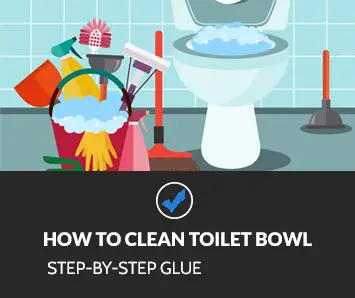
Nobody gets giddy about cleaning the toilet, but it’s a necessary activity if you want to maintain your bathroom looking nice and keeping germs from accumulating inside the bowl (and then spraying out into the rest of your bathroom with every flush).
It takes a little longer and needs more effort than simply squirting Gatorade-colored cleaning fluid all over the porcelain and stirring it with a flimsy brush you picked up at the corner store, but with the appropriate tools and a few handy hints, it’s an easy task. Frequent cleaning also reduces the ick factor significantly, so keeping it clean is important.

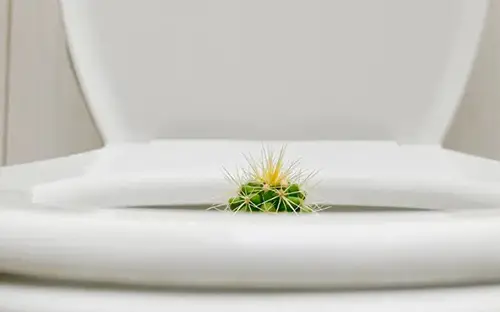
To figure out what and how to clean the toilet, you must first identify the type of pollution that is present:
By the way, as dirt accumulates on toilet bowls and cistern surfaces over time due to mechanical damage, they should never be cleaned with coarse brushes or abrasives. The presence of microcracks on the faience’s surface is also aided by hot water from the toilet bowl’s surface coming into contact with it.
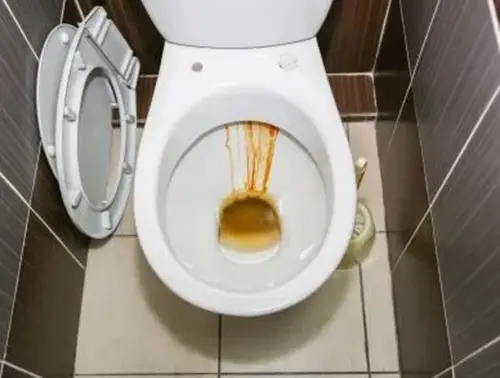
The color of the toilet’s rim and within the bowl at the water level is determined by a variety of factors. To get the best cleaning results, you must first comprehend what you’re up against.
Here are some of the most frequent toilet bowl stains:n
To keep them from mixing in with the rest of your cleaning kit, store them in a tote or bucket. It’s not a good idea to clean the sink with the toilet sponge or wash dishes using the same rubber gloves.
Disinfectants are most effective on clean surfaces. They are ineffective if they are overwhelmed with too much dirt or other grime. To begin, use a dry tissue or paper towel to wipe the toilet tank, lid, seat, and pedestal.
In a small mixing bowl, combine 2 tablespoons of baking soda (bicarbonate) with enough water to make a paste. Clean the toilet seat using a damp microfiber cloth dipped into the paste. Make sure to check both sides of the toilet seat as well as the lid. Scrub the toilet seat hinges with the remaining paste. Spray the toilet seat and hinges with hydrogen peroxide and clean them with a clean, damp towel.
The fewer water in your toilet bowl, the easier it will be to clean. So, twist the oval-shaped stop valve on the supply hose until it stops to turn off the water at the tap. Alternatively, open your tank’s lid and slide a wooden spoon underneath the float lever to keep it from moving. After that, flush away any residue with a toiletry brush or sponge under cold running water (or an old toothbrush).
Remove the toilet bowl and fill it with water. Sprinkle baking soda all around the walls of the bowl when it’s empty. Add in a few drops of tea tree oil, which has deodorizing and mild disinfection properties. To get your brush wet, put it into the water. Sprinkle the end of the brush with more baking soda and scrub under the rim of the toilet bowl. Work your way down each wall and into any drains you can reach until you hit bottom. Do not flush anything down yet.
For a toilet bowl that’s been neglected for quite some time, you might use either white vinegar or apple cider vinegar to eliminate stains and molds. As the fizzing and foaming continue, they will help to lift away stains while also destroying germs. Allow the vinegar to sit in the bowl until the foaming has stopped; then scrub it one more time. Turn on the water by rotating the valve to the left (or removing anything you used on top of it), wait for your tank to fill, and then flush.

In reality, the majority of commercial toilet bowl cleaners are harmful chemicals that may harm your home’s ecology.
Many toilet bowl cleaners include hydrochloric acid as an active ingredient. This corrosive substance is extremely hazardous. Furthermore, it poses a hazard to children, pets, and especially the toilet cleaner!
Finally, breathing hydrochloric acid fumes is detrimental to the nose, throat, and respiratory system. It’s highly corrosive if it gets on your skin.
Another hazardous component is chlorine bleach. Bleach, which is highly caustic, can burn, corrode, or damage living tissue. It’s also easy to aggravate asthma symptoms by burning your eyes, nose, and skin.
Although bleach and hydrochloric acid provide a one-two punch against germs and stains, it is not necessary to pollute your house in order to disinfect your toilet. However, there’s a reason you aren’t hearing this from large businesses: they can’t make any money if everyone cleans their toilets with vinegar. {groan} I don’t know about you, but I despise the idea of giving up those lovely blue chemicals that Big Business claims are the only things that destroy germs in bathrooms.
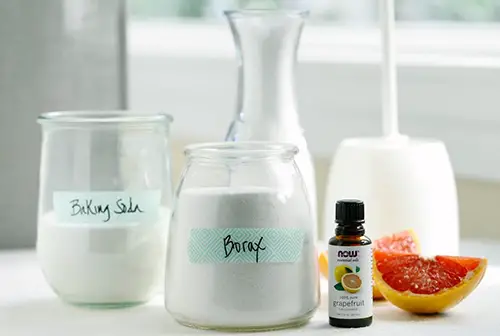
The idea of making a toilet bowl cleaner at home may strike fear in your heart, but there are several natural ingredients that may be utilized to create one. Furthermore, because you prepared it yourself, you have complete control over the chemicals used. Finally, the substances are readily available and quite effective.
Tea tree oil has antiseptic qualities that help to destroy germs in the toilet bowl and on surfaces. It’s a fantastic approach to keep a filthy, stinky toilet clean without resorting to dangerous commercial chemicals in a natural way.
Recipe for Toilet Bowl Cleaner with Tea Tree Oil
To make a toilet bowl cleaner, combine tea tree oil and vinegar in a spray bottle. Spray the toilet’s interior and exterior with the cleaning solution. Allow several minutes for it to sit before wiping it away.
To clean the toilet, use a toilet brush and add baking soda to the bowl. To clean out the toilet, fill it with a toilet brush and sprinkle in some baking soda. If necessary, use water to remove any waste particles.
This toilet bowl cleaner will remove any blockages or stains from your toilet bowl, whether it’s clogged or has difficult-to-remove marks. It’s also fantastic for removing unpleasant scents.
Homemade Heavy Duty Toilet Cleaner Recipe
To clean a toilet, fill it with four parts: one part baking soda (or bicarbonate of soda), one part vinegar, three parts water. In a glass jar combine all four components. To ensure that the toilet bowl walls are wet, flush the toilet or swish water around with your toilet brush. Allow it to rest for several hours before cleaning if necessary so that stubborn rings dissolve. To remove any traces of dirt from the bowl, brush it and then flush it clean with a toothbrush.
Toilet bombs are a popular toilet cleaning product. These fizzy cleansers eliminate sewage odors from your house and keep toilets clean during regular cleanings. These fizzy bombs, which can be made with readily available supplies, transform ordinary water into a beautiful bubble bath.
Toilet Bomb Recipe
In a mixing glass, combine the baking soda and citric acid. Next, add the essential oils and water to the mixture. When wet ingredients are added, the baking soda will fizz. The mixture should be damp sand-like in texture when squeezed and clump together.
To make toilet bombs, start by combining the kief with water in a saucepan. Increase the amount of water gradually until you reach a smooth texture. Gently drop the mixture into silicone molds. Allow to dry overnight before removing the toilet bombs. Place one toilet bomb in each bathroom and enjoy watching it perform its magic.
To make a toilet bowl cleaner, fill a glass spray bottle halfway with tea tree oil and vinegar. Spray the toilet’s interior and exterior with the cleaning solution. Allow several minutes for it to sit on both surfaces before rinsing off.
Wipe away all visible surfaces with a dry cloth. To clean the toilet bowl, fill it halfway with baking soda and use a toilet brush to scrub it. To remove any leftovers, flush the bowl.
This toilet bowl cleaner can be used to clean your restroom while removing scents. Because of its abrasive properties, baking soda cleans the bowl as well as deodorizing it.
Use a single oil or a combination of oils in this recipe to achieve a pleasant scent. In a squirt bottle, combine oils, Castile soap, and water. Shake the jar before adding the baking soda.
Mix one cup vinegar, five teaspoons baking soda, and two cups of water in a spray bottle. Spray the inside of your toilet bowl liberally, making sure to get the rim as well. Scrub inside with a toilet brush. Allow hydrogen peroxide to sit on the sides of the bowl for several minutes. To rinse everything out, flush it all down the toilet.
Nobody wants to experience toilet difficulties, and they are almost always inconvenient. A clogged toilet is one of the most aggravating and smelly problems imaginable. Unclogging a toilet is certainly an emergency situation whether your youngster dropped your keys in the bowl or there is a significant blockage due on account of a large accumulation of toilet tissue.
Boiling water is one of the first strategies to try when unclogging a toilet. Bring water to a boil on the stove. Make sure there is no water in the drain line while the water heats up.
Fill the toilet with boiling water and let it drain. If that doesn’t work, try another pot of boiling water. Try a different approach if the second attempt fails as well.
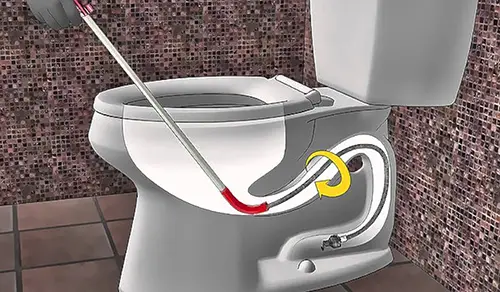
In most big-box retail stores, you’ll find a drain snake or drain auger. Snakes can be manually orelectric, and they may assist you in removing blockages that are deep within your pipes.
Place the end of the snake into the drain and begin twisting the handle while pushing it in. Continue turning until you feel that the obstruction has been removed. To be sure, use water to flush away any remaining debris.
It’s conceivable that a blockage is more challenging than we expect. Unclog your toilet in minutes with this powerful home-made natural drain cleaner.
Recipe for Homemade Drain Cleaner
To unclog a toilet, fill it with a gallon of boiling water. Allow the baking soda to soak for several minutes before stirring in two cups of vinegar and one cup of hot water and pouring down the drain.
To prevent a chemical reaction and potentially an overflow, close the toilet lid. If this doesn’t work, allow it to rest in the bowl for 20 minutes before pouring a gallon of boiling water down the drain. If this does not work, consider looking at different ways to unblock a clogged toilet.
The ingredients in this recipe, similar to our hard water stain remover, are all natural. To make stain removal easier, we added an extra component to our rust remover tip and it’s also a fantastic toilet cleanser.
Homemade Rust Stain Remover Recipe
It takes two minutes to learn how to clean a toilet bowl. The first step in learning how to clean a toilet bowl is knowing how to eliminate even the most tenacious stains. Before you start, make sure the main valve for your toilet is off and any standing water is removed with a cup.
Add the vinegar to the basin directly, then add the baking soda. Swish stain remover around inside for 15 minutes with a nylon brush to remove stains. If stains are still visible, consider using lemon juice rather than chlorine bleach. After shutting off the water supply, run water on the basin to rinse it out.
The toilet bowl cleaner has one disadvantage, in that it isn’t as strong as commercial cleaners. The natural cleanser is effective on both the inside and outside of your toilet.
DIY Toilet Bowl Cleaner Recipe
Combine the essential oil and a wooden spoon in a bowl. Using a wooden spoon, mix the essential oil and baking soda together. Before being kept in a glass jar, all oil clumps should be broken down.
You should clean the toilet bowl with a toilet brush after adding one tablespoon of cleaning solution to it and then scrubbing it. After pouring vinegar in and allowing it to fizz, scrub again with a brush. Rinse the toilet by repeating the process once more.
A toilet bowl cleaner prepared at home is one of the most efficient ways to clean a toilet. The solution is powerful enough to clean the toilet’s base using only a few basic items.
All-Purpose Bathroom Cleaning Spray Recipe
Spray the bottle halfway with warm water. Preheat the oven to 200°F (93°C). Take a clean cloth and wipe away any debris from the outside of your toilet. To use it, spray everything liberally, including your toilet seat, base, and bowl. Clean out any particles from around your toilet using a nylon brush. Using a nylon brush, clean out the inner parts of your toilet.
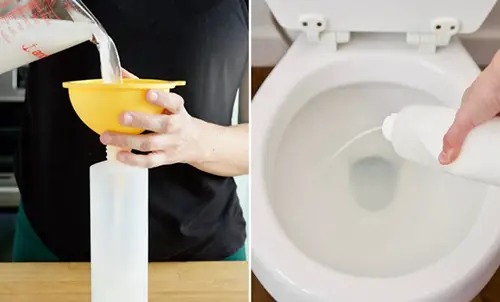
Deep clean your toilet’s interior using a half cup of baking soda and tendrils of tea tree oil, which are both all-natural cleaning products. Commercial cleaners are equally effective in cleaning and disinfecting as natural cleansers that use natural ingredients.
Pour in a quarter cup white vinegar after. Scrub the interior of the pan until clean while the cleaners fizz.
Baking soda is a powerful solvent and antibacterial, making it ideal for cleaning drains. The non-corrosive drain cleaner is simple to create and safe enough to use on toilets as well as other drains in the house.
Organic Drain Cleaner Recipe
Place the container with the baking soda, cream of tartar, and salt in a medium-sized mixing bowl. Add a little water at a time until you have a creamy liquid. Allow to stand for 20 minutes before flushing it down the toilet. Repeat as needed until the clog is cleared.
This enzyme cleaner is strong enough to remove stubborn clogs, not to mention it will leave your pipes smelling fresh and new.
Recipe for Organic Enzyme Cleaner
Fill a container with as many citrus peels as will fit and cover them in vinegar. Cover the jar with the top and leave it for two weeks. For citrus infused vinegar, strain the citrus peels from the vinegar. Some baking soda down the blocked or stinky drain will help to clear it. Follow with a combination of equal parts citrus vinegar and vinegar. Allow to sit for 30 minutes before removing the cover. After that, pour two cups of boiling water over it.
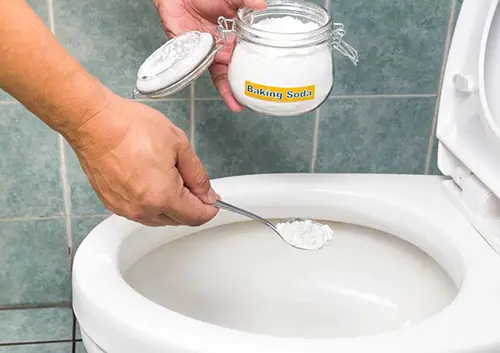
If your toilet has chalky, off-white stains, you’ll want to know how to get rid of lime scale-induced stains. These hard water toilet stains are caused by minerals accumulated while water flows through soft rocks like chalk and limestone. Lysoz Power Toilet Bowl Cleaner Lime & Rust Remover is the best toilet cleaner for these sorts of stains in our collection. Follow these simple steps for removing stubborn toilet stains above and below the waterline:
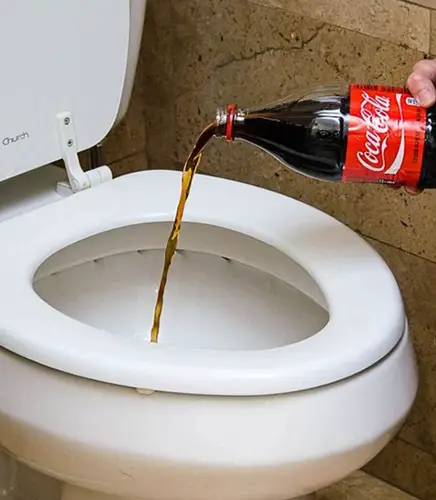
Brown or orange stains in the toilet are frequently caused by hard water that has passed through the bowl, leaving traces of minerals behind. Rust stains in the toilet, for example, might be blamed on contact between water and iron compounds, which leave a red residue when they come into touch with air.
Brown rings in the toilet are left by rust stains. Rust stains are particularly hard to remove and leave a brown ring in the toilet. For removing these difficult toilet stains, use our Lysol Lime & Rust Remover—simply follow the same treatment as for limescale in your toilet!
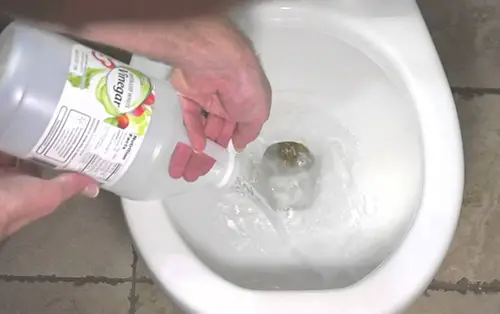
Mineral deposits and hard water may accumulate in your toilet bowl quickly if they are not removed. Not only are these stains unsightly, but they’re also difficult to remove using a regular toilet cleanser and brush.
An ounce of prevention is worth a pound of cure, as hard mineral stains in your toilet bowl demand immediate action. Using a standard cleaning solution to get rid of the first indications of a mineral stain in your toilet is your best bet. If it continues, some regular TLC may go a long way toward preventing the problem from getting worse.
There are a few simple methods to remove mineral stains from your toilet with items you may already have at home, as there are several products on the market today created especially to get rid of stains that might build up in your toilet bowl.
Baking soda and vinegar are two effective interior house cleaners, especially when used together. Follow these steps to remove mineral stains from your toilet bowl with baking soda and vinegar:
You may believe that putting soda in your toilet bowl to remove mineral deposits is a waste of time, but it can be very beneficial for removing stubborn stains. To empty the toilet and prevent it from filling up again, first flush it. Alternatively, you might either turn off the water at the shutoff valve and then flush the toilet or do both at the same time. Fill the bowl nearly to the top with a few liters of cola and then drain it through a strainer. Allow the liquid to sit for an hour or two so that the acidic soda can eat away at the stains – overnight is ideal. The following morning, flush down the soda with water and use a stiff brush or pumice stone to remove any remaining residue.
Borax is an excellent cleaning product that, when combined with vinegar, can remove mineral deposits and hard water. This combination may also be used in your toilet and other plumbing fixtures. Here’s what you need to do:
This toilet cleaning technique is for extremely persistent mineral stains. Here’s what you need to do:
After the paste has sat for a while, use a firm brush to remove it and clean the stains off. When you’re done, remember to turn on the water to your toilet once more!
A scrub brush, on the other hand, might perform better than a normal toilet brush for any of the methods described above. If you choose to use borax paste as a stain remover, a toilet brush may struggle to reach into the bowl because the paste is tougher than the bristles – it isn’t as efficient. A scrub brush’s thicker times will generate enough friction against stains to offer decent hope of removal. Wear rubber gloves and apply plenty of elbow power when doing this so you can notice a difference.
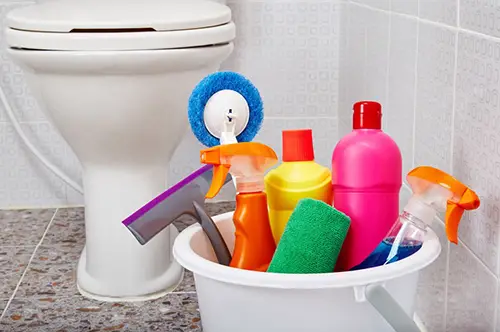
If a toilet brush is orange or brown rather than white, it should be replaced. Instead of utilizing a toilet brush, which is difficult to keep clean, use a tool, sponge or cloth that can be disposed of or washed hygienically after each usage.
If you can see a day’s usage in your toilet bowl, you’ll need to clean it quickly to avoid germs from multiplying and being sprayed around the room with each flush. Bleach is one of the most effective bacterial killers, but if you like, you may use a more natural approach such as baking soda combined with vinegar.
A weekly thorough scrub may be enough if you don’t have to clean your toilet bowl every day. A bleach-soaked toilet brush should suffice, but nailing the cleaning might take some arm work. You’d be shocked and perhaps disgusted to know what lurks beneath the average toilet bowl’s rim, so it’s important to thoroughly clean that area to decrease the risk of disease-causing germs developing there.
A combination of vinegar and baking soda may be used to clean toilets effectively, and the odor won’t linger in your nose and sting your eyes like some chemical cleaning solutions might. The monthly cleaning usually necessitates a lot of elbow work, especially if you haven’t been doing weekly cleans or need to spray a solution around the entire toilet bowl and leave it there overnight without flushing. If you do an overnight soak, all you have to do in the morning is give it a light clean with a brush, and your toilet bowl will be as good as new.
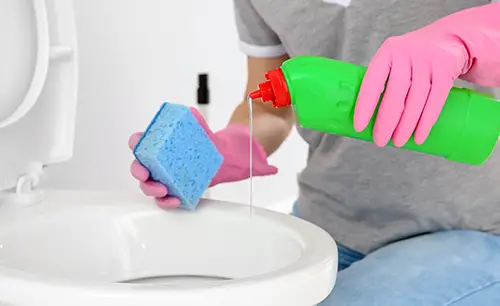
It appears that it would be a waste of time to go through all of this trouble to remove the stains from the toilet bowl only to have to repeat it in a week or two.
Therefore, stick to the following:
Take some time to figure out what sort of stain you’re dealing with, why it appeared in the first place, and what kind of assistance might help you get rid of it most effectively.
The better solution, from both an environmental and health standpoint, is to use natural treatments to get the stains out. If your toilet bowl is badly stained, you’ll need more elbow work and some chemicals might be required.
Scrub your toilet as often as you can, if not daily. That’s the best way to keep stains at bay.
Check everything for any damages before you put it back. Make sure everything is clean and return it to its original location. Crease the toilet tissue in the wall mounted dispenser into a triangle to add a nice touch. This will give it a hotel-style appearance while also letting our customers know that “a job well done” has been accomplished.
Did you see our favorites?
CleaningProductsLab.com is a participant in the Amazon.com Services LLC Associates Program. As an Amazon Associate we earn from qualifying purchases.
Amazon and the Amazon logo are trademarks of Amazon.com, Inc. or its affiliates.
The information on this blog is not meant as a substitute for medical advice, and should not be taken as such.